Dracaena Fragrans (Corn Plant): Care and Growing Guide

The Dracaena fragrans—also named the corn plant—is a flowering plant species native to Africa. The corn plant is a popular ornamental houseplant because it thrives in most indoor environments. Growing in low light or bright light, the Dracaena fragrans produces glossy green foliage. The broad lanceolate leaves form an attractive crown of arching leaves at the top of a woody stem, which gives the corn plant the appearance of a small tree. Also called cornstalk plant or the happy plant, Dracaena fragrans can be grown in a shaded corner, bright room, or office with only artificial light.
How to Care for Dracaena Fragrans – Overview
To care for the corn plant grow it in loose, moist potting soil that has good drainage. Dracaena plants grow best in average humidity and a temperature range of 60°F to 75°F (15°C – 24°C). Water when the top inch of soil is partly dry and feed every 3 weeks in the growing season.
Dracaena fragrans grows outdoors in USDA zones 10 and 11. When mature, these slow-growing shrubs can grow to 50 ft. (15 m). The long, tapering leaves can measure 5 ft. (1.5 m) long and 5” (13 cm) wide. Growing indoors, corn plants reach up to 6 ft. high (1.8 m) and are suitable as a tall houseplant for your home.
Cornstalk Plants (Dracaena Fragrans) Flower
Cornstalk plants (Dracaena fragrans) flower occasionally indoors. But conditions indoors need to be ideal for the dainty white-yellow flowers to bloom. Most people keep corn plants for their spiky foliage rather than their less than showy flowers.
Types of Dracaena Fragrans
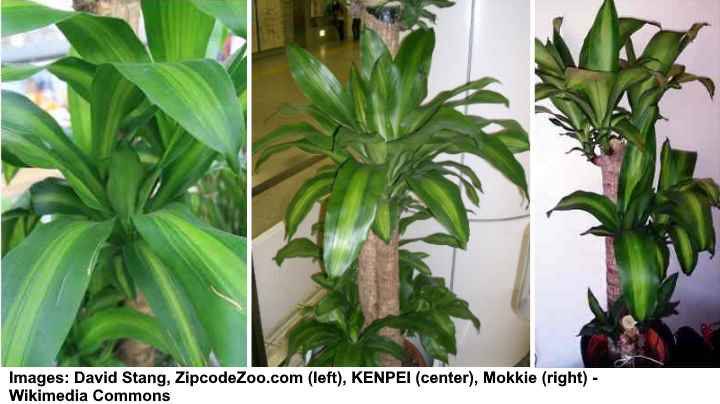
Pictures of Dracaena fragrans ‘Massangeana’. The corn plant has the appearance of a small tree and it’s on the list of tall indoor plants.
The most common type of corn plant is the Dracaena fragrans ‘Massangeana’ (also called mass cane plant). This cultivar thrives in bright light, and its glossy green foliage has a lime green or yellow stripe running the length of its center.
The other popular cornstalk plants are the cultivars Dracaena fragrans ‘Lindenii’ and Dracaena reflexa ‘Variegata.’ These cultivars have bright yellowish stripes on the leaf edges. Another attractive corn plant is the Dracaena fragrans ‘Victoria.’ This short-stemmed plant has leaves similar to ‘Massangeana,’ only that they are shorter and more triangular-shaped.
Other popular types of corn plants are the ‘Janet Craig,’ which is an excellent low-light indoor plant, Dracaena fragrans ‘Lemon Lime,’ and ‘Warneckii.’
How to Care for Dracaena Fragrans (Corn Plant)
Although Dracaena plants seem to thrive on neglect, they have some care requirements to help them thrive. The most crucial factors when it comes to caring for corn plants is to water them properly and get the lighting right.
Please read on to find out more care tips for your spiky houseplant.
Light Requirements Growing Dracaena Fragrans Indoors
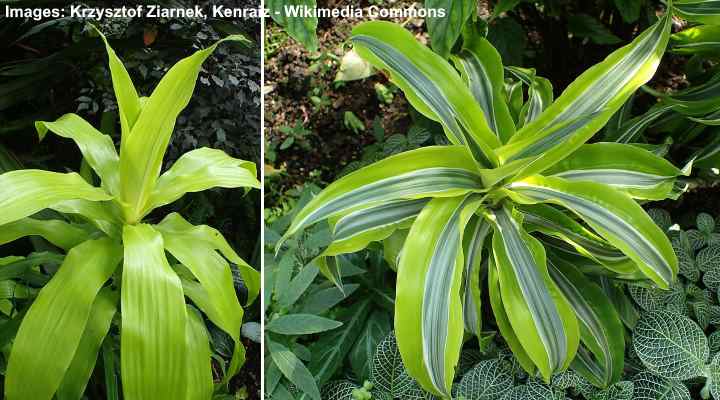
Images of Dracaena fragrans ‘Limelight’ (left) and ‘Lemon Lime’ (right)
The best place to grow a corn plant in is in a bright location in your home that has some shade. Although many Dracaena cultivars are low-light houseplants, the variegated varieties need bright, indirect sunlight. You’ll also find that corn plants grow faster when placed in a sunny spot.
Variegated species of Dracaena fragrans thrive on an east-facing windowsill. The early-morning sun isn’t strong enough to cause leaf burn. In a room facing south or west, keep the plant a few feet away from the window. The Dracaena cultivars with dark-green foliage thrive better in north-facing rooms or offices with artificial light.
Lighting conditions can affect the plant’s growth rate. For example, when growing in complete shade, the naturally slow growth of the plant can almost come to a halt. Also, brightly-colored foliage on some species may fade. If growing in direct sun for too long, the leaves will become discolored and wilt.
The Best Soil for Dracaena Fragrans
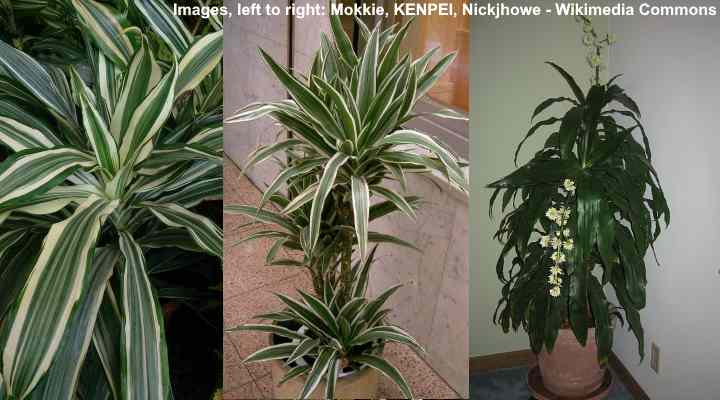
Dracaena fragrans ‘Warneckei’ (left, center) and ‘Janet Craig’ (right) – Dracaena plants need well-draining potting soil with plenty of organic material
Potted corn plants need loose, well-draining potting soil with plenty of organic material to thrive. Even though all species in the genus Dracaena are easy houseplants to care for, they can’t stand in soggy soil. You can create the perfect potting medium by mixing potting soil, peat moss, and perlite.
The appropriate potting soil should allow water to drain freely. The addition of perlite helps to aerate the soil and improve drainage. The peat moss in loamy soil adds essential nutrients to the growing medium and also retains just enough moisture. This type of soil helps to prevent moisture problems that can lead to root rot.
How can you tell if your potting soil is right for corn plants? A potting medium that is too dense causes water to pool on the surface. You may also notice that water doesn’t drain as quickly as it should in heavy soils. Two solutions can help improve soil drainage:
- Add perlite or pumice to the potting soil to create a looser growing medium that lets water drain freely.
- Transfer the corn plant to a larger container to prevent the plant from becoming root-bound.
How to Water Dracaena Fragrans

Dracaena fragrans ‘Warneckei’ has variegated foliage with dark green and cream leaves
How often should you water cornstalk plants? As a general rule, water Dracaena fragrans as often as the top 1” to 2” (2.5 – 5 cm) of soil dries out. Watering when the soil is partly dry prevents moisture problems in the pot. You also ensure that the roots are kept consistently moist.
The best way to water corn plants is to soak the soil thoroughly and allow excess water to drain. Before watering, it’s best to let water sit in a jar for 24 hours. This helpful watering tip allows chemicals in tap water to evaporate and causes less stress for your houseplants.
Also, water at room temperature is better than icy-cold tap water for hydrating tropical indoor potted plants.
One of the most common mistakes to avoid if you want your Dracaena fragrans to thrive is to water on a schedule. Corn plants—similar to most houseplants—only need watering when the soil partially dries. It’s always a good idea to check how dry or moist the soil is before deciding to water.
Temperature Requirements When Growing Dracaena Fragrans as a Houseplant
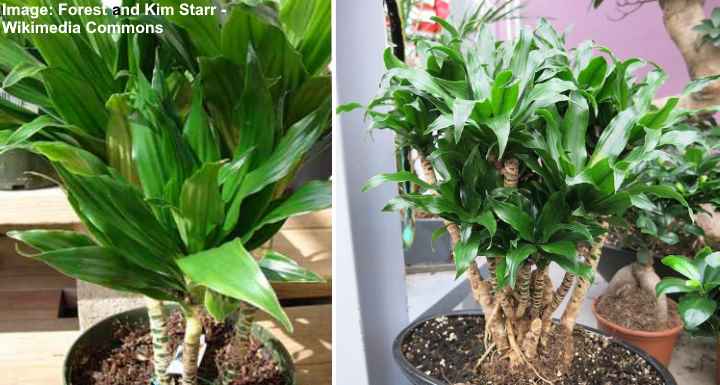
Dracaena fragrans ‘Compacta’
Corn plants thrive in average room temperature between 60°F to 75°F (15°C – 24°C). It is vital to keep the temperature as even as possible to avoid sudden fluctuations. Changes in temperature can cause the plants to be stressed and affect their growth. Try to keep plants out of cold drafts and away from hot radiators.
Dracaena fragrans grow outdoors as long as the average temperature is above 60°F (15°C). If you live in temperate climates, you can take potted corn plants outside in summer. Keep the plants in a bright spot, but shaded from direct sunshine. Bring back indoors when the temperature drops below 50°F (10°C).
How Much Humidity Does Dracaena Fragrans (Corn Plant) Need?
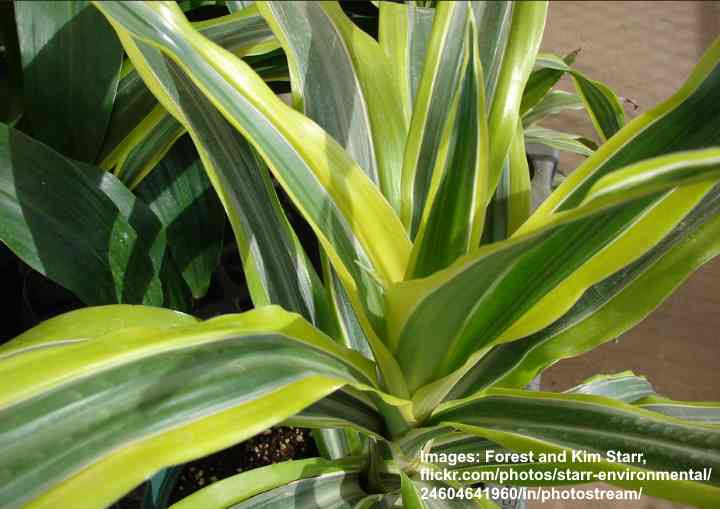
Dracaena fragrans ‘Lemon Lime’ has variegated leaves with lime green on the sides and darker green in the center
For Dracaena fragrans plants to thrive, aim for humidity levels between 40 and 50 percent. So, corn plants should thrive in average room humidity. Brown tips on the leaves mean you should increase air moisture levels. Mist the plants once a week or wipe the leaves with a damp cloth.
One of the challenges when growing Dracaena plants indoors is keeping air humid in winter. Heating tends to dry out the air in the home. And, because corn plants need less watering in the winter, they can suffer from a lack of moisture. Therefore, pay attention to humidity levels in winter.
Some ways to increase humidity for Dracaenas include:
- Misting—Fill a spray bottle with distilled or filtered water. Create a fine mist around the plants leaves without spraying directly on the leaves. Mist once a week for the best results.
- Humidifying tray—Make a humidifying tray by putting a layer of pebbles in a deep dish. Fill the dish with water until it reaches half-way up the pebbles. Place the corn plant container on the stones, making sure the bottom of the pot isn’t in contact with the water.
- Wipe the leaves—Once a week, take a damp cloth and wipe the corn plant leaves. The dampness acts to moisten the leaves and also cleans them from dust at the same time.
Dracaena Fragrans Flowers
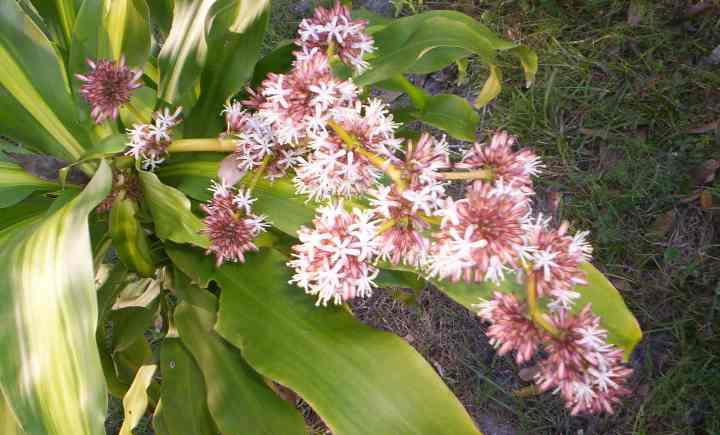
Flowers of Dracaena fragrans ‘Massangeana’
A mature corn plant may flower indoors occasionally. The flowers grow on a long branching panicle that produces whitish-pink buds. These buds bloom in the evening and give off a strong fragrance. However, many plant owners trim off flowering stems to help concentrate growth in the main plant.
Corn Plant (Dracaena Fragrans) Growth Rate
All species of Dracaena fragrans have a slow growth rate, even in ideal conditions. Growing at a slow pace, corn plants will last a long time as an ornamental indoor plant without getting too big. The main factor affecting Dracaena’s growth is light—plenty of bright indirect light encourages the best growth.
Fertilizer Needs for Dracaena Fragrans to Thrive
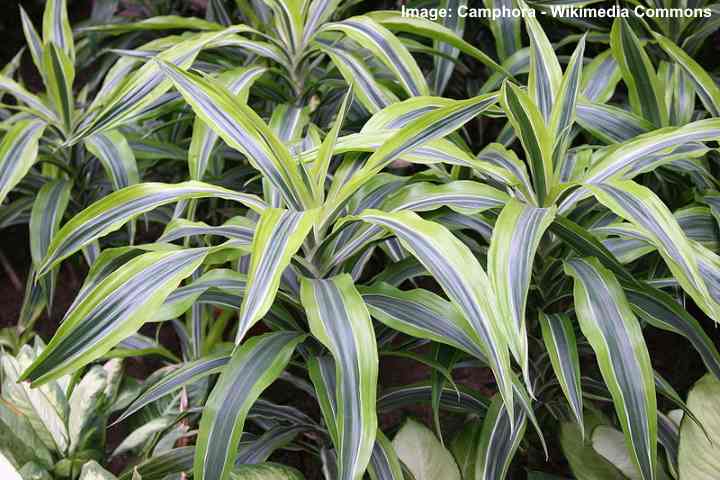
Dracaena fragrans ‘lemon lime’
Due to their modest growth rate, corn plants don’t need much fertilizer to thrive. Growing in organically-rich soil provides plenty of nutrients. You can boost growth by using a balanced liquid fertilizer monthly. You should only feed the plant during the spring and summer—the growing months. Don’t feed in winter.
It is vital to prevent a buildup of fertilizer salts in the potting soil. Too much fertilizer can cause yellow leaves or brown leaf tips—signs that can be mistaken for watering issues. Flushing the soil is one way to avoid a buildup of minerals. Here are the steps you need to flush the potting mix:
- Take the corn plant container to the bath or outdoors.
- Gently run water through the soil to drench it thoroughly.
- Let the water flow through for two to three minutes.
- Allow all the water to drain completely before putting the plant back in its favored location.
- Repeat the flushing two or three times during the growing season.
Dracaena Fragrans Propagation
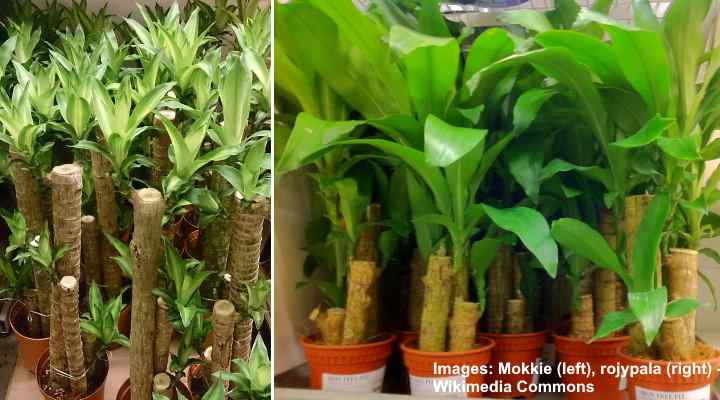
Propagating Dracaena fragrans is done through stem cuttings
Corn plants are easy to propagate. In time, cornstalk plants become leggy as most of the foliage grows at the top of the stem, giving it a tree-like appearance. The way to propagate a Dracaena plant is to cut the woody stem into three pieces. You will have the crown section, the root section, and a middle part.
First, cut off the crown, leaving about 5” (12 cm) of the stem. Plant the newly-cut stem in a pot with a fresh, sterile potting mix.
Second, cut the remaining stem with the root system about one-half of its length. New growth will appear at the cut section, eventually forming a new crown of spiky-looking foliage.
Thirdly, you can use the middle section of the stem to propagate a new corn plant. Allow the cut stem to dry for a few days. Then plant the stem in a fresh potting medium, ensuring that the plant is growing the same way up as before. Keep the soil warm and moist to help the propagated stem take root.
Pruning Dracaena Corn Plants
It’s not necessary to prune corn plants to encourage growth or a bushy appearance. The lower leaves naturally turn yellow and drop off as the plant grows and matures. If the corn plant starts to grow too tall, you can prune the stem back following the propagation method above.
How to Repot a Corn Plant (Dracaena Fragrans)
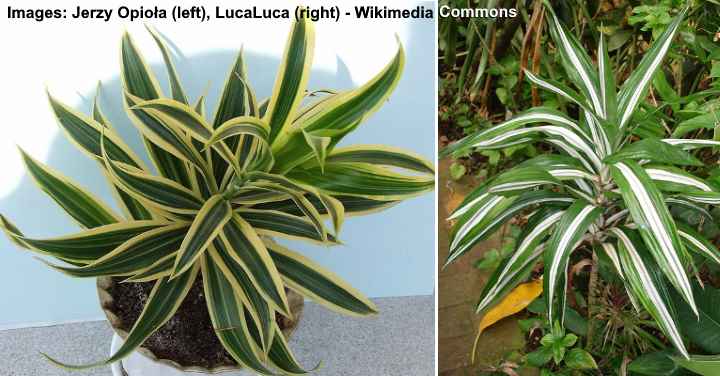
Dracaena fragrans cultivars with various variegated leaves
You may need to transfer a corn plant to a larger container every two to three years. Species of Dracaena fragrans don’t mind being slightly rootbound. However, the plant’s growth will become stunted if roots fill the pot too much. To repot a Dracaenas species, choose a container one or two sizes larger than its current one.
To repot any type of Dracaena fragrans, this is what you should do:
- Pull the thick stem to remove the plant’s root ball from the container.
- Shake off excess dirt and run the roots under water to clean them.
- Inspect the roots for signs of rotting or decaying and trim as needed.
- Half-fill a larger container with the appropriate potting mix.
- Put the plant in the pot and fill the remaining space with soil.
- Thoroughly water and place in a bright spot, protected from direct sunlight.
Pests Affecting Dracaena Fragrans Growth
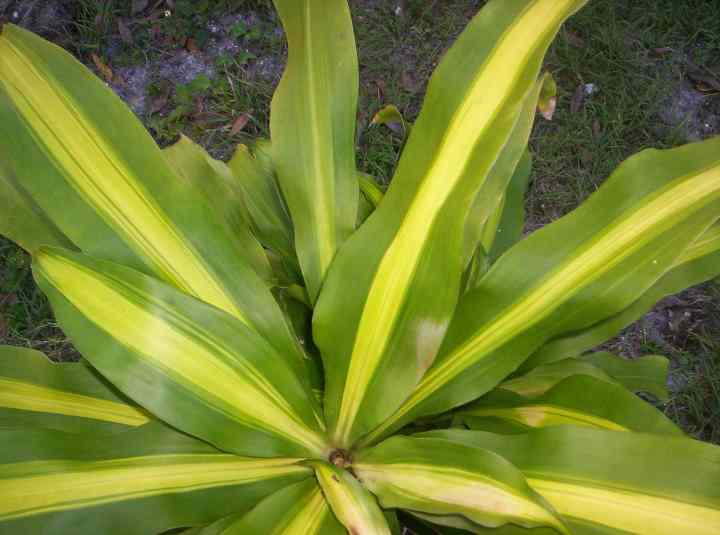
Dracaena fragrans ‘Massangeana’ leaves are yellow or lime green in the middle and darker green on the sides
Pests such as thrips, scale, and spider mites can infest corn plants. It’s crucial to get rid of houseplant pests as soon as possible. Otherwise, the infestation can become so bad that your plant ends up dying. If you notice signs of plant bugs, wipe the leaves with insecticidal soap or treat them with a neem oil solution.
For more information, please read this article on how to get rid of pests from houseplants naturally.
Common Dracaena Fragrans Plant Diseases
Most diseases that affect corn plants are the result of overwatering. Plant roots that sit in waterlogged or overly damp soil can develop fungal or bacterial diseases. These issues can cause soggy stems, brown spots on leaves, and—eventually—death. To avoid doing irreparable damage to your plant, only water when the soil partially dries.
Overwatering can also cause mold issues on plant soil. Although harmless, white plant mold can ruin the plant’s appearance. Please read this article to find out how to remove mold from potting soil.
Is Dracaena Fragrans (Corn Plant) Toxic?
Dracaena fragrans plants contain poisonous substances that can harm pets such as cats and dogs. The American Society for the Prevention of Cruelty to Animals (ASCPA) says that cornstalk plants (Dracaena) contain toxic chemical compounds named saponins. If ingested, these can cause vomiting, excessive drooling in cats, dogs, and horses. (1)
FAQs About Growing Dracaena Fragrans (Corn Plant) Indoors
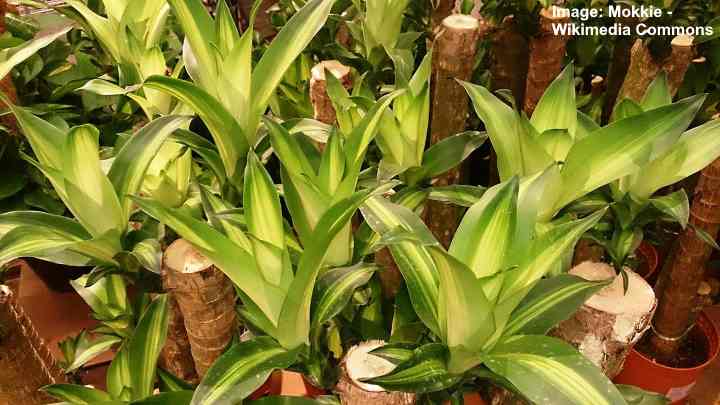
Can Dracaena Fragrans Plants Help Clean Indoor Air?
According to NASA research, many types of corn plants show the potential of filtering harmful chemicals from the air. The list of clean-air plants in NASA’s study included Dracaena massangeana, Dracaena marginata, and Dracaena deremensis ‘Janet Craig.’ The research found that these plants can help remove indoor pollutants such as toluene, formaldehyde, and xylene. (1)
How to save a dying Dracaena Fragrans
If your corn plant looks like it’s dying, it crucial to find the root cause. Because this plant is generally easy to care for, the most common reason for weak growth is overwatering or pest problems. To help revive a dying Dracaena fragrans, try repotting it in a fresh potting mix if excess moisture has caused fungal diseases.
Why are corn plant (Dracaena fragrans) leaves turning yellow?
If the leaves lose their green color and become pale yellow, overwatering is usually to blame. Too much soil moisture often causes weak, limp leaves and a soft, mushy stem. The best way to save your plant is to hold off watering until the top 2” (5 cm) of soil dries completely.
Why have leaves on my Dracaena fragrans got brown tips?
Brown tips on the pointed green Dracaena leaves are due to lack of water or lack of humidity. Make sure and water your corn plant as often as needed—when the soil is partly dry. If the soil is moist, and you still get brown tips, try increasing humidity by misting the plant every other day.
Related articles:
- Tall Indoor Plants for Homes and Offices
- Dieffenbachia Plant (Leopard Lily, Dumb Cane) Care
- Aglaonema Care: How to Grow Chinese Evergreen
